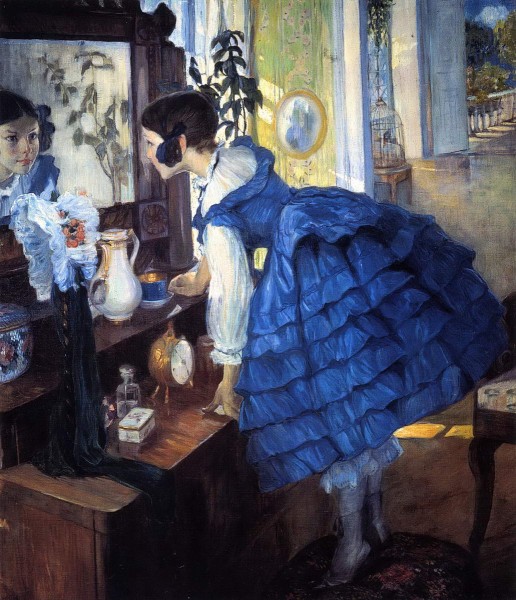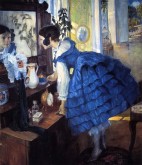Little Woman
1910
- . 129 x 110.5
- Ж-2137
Пост.: 1911, приобр. с выставки НОХ
- Period Late 19th century – Early 20th century
- CategoryPortrait, Genre Painting
- Share
Intricately interwoven in this painting are the past and the present, admiration of the delight of childhood and elegiac melancholy about the quick passage of time, thoughts about the succession of the generations. The painting depicts the artist's daughter, Yekaterina Kardovskaya (1900 - 1986). The ten-year-old girl is looking inquisitively at her reflection in the old ("granny's") mirror , and bet ween the toys and her naïve impersonation of adults, it seems that she has noticed for the first time that she is growing up and aware of the attraction of her appearance. She is portrayed in the sun-drenched environment of a noble estate of the mid-nineteenth century, surrounded by elegant objects, the silent witnesses of a bygone era. At the beginning of the twentieth century, Russians associated this world with the era of Turgenev and considered it to be the realization of beauty, harmony and humanity, gone forever from people's lives. Play and Passion in Russian Fine Art. St-Petersburg. 1999. P. 45.
Like the majority of students of Ilya Repin, Olga Della-Vos-Kardovskaya was a passionate portraitist. She herself painted many acclaimed images of Anna Akhmatova, Nikolai Gumilyov and Dmitry Kardovsky. Based on a portrait of the artist’s daughter, Little Woman is tinged with retrospectivism. The ten-year-old model peers inquisitively at her own reflection in an old mirror. The girl is depicted in the sunlit environment of a mid-nineteenth-century manor-house, surrounded by various elegant objects – silent witnesses of the past. For many Russians living in the early twentieth century, this world was associated with the Ivan Turgenev period. It was perceived as an embodiment of a lost beauty, harmony and humanity, subtly expressed in Andrei Bely’s Gold in Azure cycle of poems and the prose of Ivan Bunin. As in the works of the other Neo-Romantic artists of St Petersburg, Little Woman whimsically intertwines the past and the present, admiration for the charm of youth, elegiac sorrow at the swift passage of time and reflections on the continuity of the generations.

